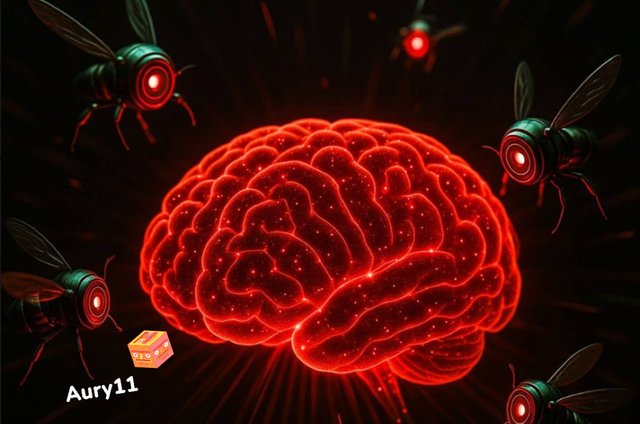NANOROBOT CONTRO GLI ANEURISMI CEREBRALI: SVOLTA MEDICA O RISCHIO INVISIBILE?
verisione in italiano 🧠
NANOROBOT CONTRO GLI ANEURISMI CEREBRALI: SVOLTA
MEDICA O RISCHIO INVISIBILE?
Un gruppo di ricercatori dell'Università di Edimburgo ha compiuto un importante passo avanti nella lotta contro gli aneurismi cerebrali, grazie a una tecnologia innovativa basata su nanorobot magnetici. Questi minuscoli robot, grandi meno di un batterio, sono in grado di raggiungere in modo mirato i punti più delicati del cervello e rilasciare farmaci coagulanti per sigillare gli aneurismi prima che si rompano, potenzialmente evitando ictus devastanti.
I risultati, pubblicati sulla rivista Small, si basano su test condotti su conigli, nei quali i nanorobot sono stati guidati con un campo magnetico fino a un aneurisma artificiale, riuscendo a chiuderlo efficacemente con un coagulo stabile. Nessuno dei soggetti ha mostrato effetti negativi nel breve termine. I vantaggi sono evidenti: niente impianti permanenti, interventi meno invasivi e maggiore precisione nel trattamento. Il sistema, in teoria, permette ai chirurghi di evitare manovre rischiose nei complessi vasi sanguigni del cervello. Tuttavia, non mancano le preoccupazioni. La tecnologia è ancora in fase sperimentale e lontana dall'essere approvata per l'uso umano. Restano aperte
questioni cruciali:
• Cosa succede ai nanorobot dopo il trattamento? Possono essere eliminati dall'organismo senza danni?
• Possono causare reazioni immunitarie o effetti collaterali nel
lungo periodo?
• La guida magnetica è sufficientemente precisa anche in pazienti umani, con vasi più profondi e complessi?
• E infine, chi controllerà l'uso di tecnologie così avanzate e potenzialmente manipolabili?
Il rischio, secondo alcuni esperti, è quello di introdurre nel corpo umano sistemi intelligenti non completamente compresi, che potrebbero interagire in modo imprevisto con l'ambiente biologico. In definitiva, i nanorobot potrebbero rappresentare il futuro della neurochirurgia, ma la loro adozione solleva anche seri interrogativi etici, medici e di sicurezza. Sarà fondamentale che i prossimi studi non si limitino all'efficacia, ma indaghino a fondo le implicazioni a lungo termine dell'introduzione di robot microscopici nel corpo umano.
link articolo completo :
https://www.livescience.com/health/scientists-invent-nanorobots-that-can-repair-brain-aneurysms
grazie per aver letto il mio post 🧚♂️
photo editate da me con ausilio di ia 🤖
the end 🙂↔️
aury11
version english 🧠
NANOROBOTS AGAINST BRAIN ANEURYSMS: MEDICAL BREAKTHROUGH
OR INVISIBLE RISK?
A group of researchers from the University of Edinburgh has made a major breakthrough in the fight against brain aneurysms, thanks to an innovative technology based on magnetic nanorobots. These tiny robots, smaller than a bacterium, are able to specifically reach the most delicate areas of the brain and release clotting drugs to seal aneurysms before they rupture, potentially preventing devastating strokes.
The results, published in the journal Small, are based on tests conducted on rabbits, in which nanorobots were guided with a magnetic field to an artificial aneurysm, effectively closing it with a stable clot. None of the subjects showed any short-term adverse effects. The advantages are clear: no permanent implants, less invasive procedures, and greater precision in treatment. The system, in theory, allows surgeons to avoid risky maneuvers in the brain's complex blood vessels. However, there are concerns. The technology is still in the experimental phase and far from being approved for human use.
Crucial questions remain:
• What happens to nanorobots after treatment? Can they be eliminated from the body safely?
• Can they cause immune reactions or long-term side effects?
• Is magnetic guidance precise enough even in human patients, with deeper and more complex vessels?
• And finally, who will oversee the use of such advanced and potentially manipulable technologies?
The risk, according to some experts, is introducing incompletely understood intelligent systems into the human body, which could interact unexpectedly with the biological environment. Ultimately, nanorobots could represent the future of neurosurgery, but their adoption also raises serious ethical, medical, and safety questions. It will be crucial that future studies not only focus on efficacy, but also thoroughly investigate the long-term implications of introducing microscopic robots into the human body.
Full article link:
https://www.livescience.com/health/scientists-invent-nanorobots-that-can-repair-brain-aneurysms
Thanks for reading my post 🧚♂️
Photos edited by me with the help of AI 🤖
The end 🙂↔️
aury11

Tema affascinante ma anche un po’ inquietante! La prospettiva di usare nanorobot per prevenire gli aneurismi apre sicuramente scenari incredibili per la medicina.
Però è fondamentale che il progresso tecnologico vada di pari passo con prudenza, etica e tanta ricerca.